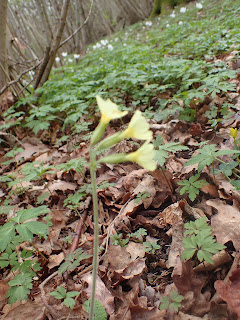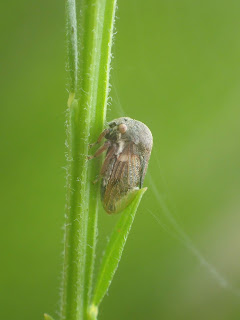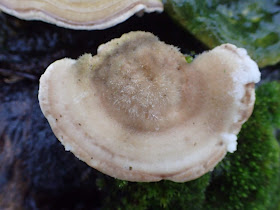As its nearly the end of the year, I have allowed myself a nostalgic stroll back through 2019, and compiled ten highlights. As usual in no particular order and a mixture of species, places, surveys and searches, which avid readers will have already read about.
1. Bradfield Woods
Cathy & I have a sort of tradition where we make sure that we visit a wood with lots of Bluebells every spring, and this year we decided to make a first visit to Bradfield Woods in Suffolk. One of the reasons for choosing this site was that it also contains Oxlips, a scarce species that I'd never seen and where the native populations are probably extinct in Norfolk. It was a chilly day as we sat at a picnic bench for our lunch, before setting off on a walk around the wood. We saw lots of woodland flowers including the hoped for Oxlips, and as a bonus I recorded the several tachinids including my favourite, Phasia hemiptera, and one possib ly new to Suffolk, Tachina lurida.
Phasia hemiptera
Tachina lurida
2. Duke of Burgundy
A few years ago I'd looked for Duke of Burgundy in the Chilterns without success, so this years trip outside East Anglia was a return visit with Carl Chapman. We visited the same area although at the other end of the ridge, and this time I got to see them! Our first sighting was of one flying past at speed, and I was worried that would be it, but fortunately I then found one on some Hawthorn blossom and we went on to see quite a few more of these lovely orange butterflies.
3. Small Fungus Weevil (Platystomos albinus)
Who lives in a fungus and looks like bird poo? No it's not Spongebob Squarepants, it's a small fungus weevil called Platystomos albinus. It's listed as Nationally Scarce B, but it might well be overlooked. After many years of looking I had finally seen it's larger relative the Scarce Fungus Weevil in 2018, so I was very pleased to find this out of the blue whilst in the Chilterns. I found it near a small gate so everyone had to wait for me to photograph it before they could come past!
4. Wheatfen Cowbane rust hunt
A brief description of the day could have been "a small group searched for a small rust fungus on umbellifer leaves and didn't find it", which doesn't really sound like a highlight. However brief descriptions often omit some key detail (remember the viral Wizard of Oz summary "Transported to a surreal landscape, a young girl kills the first person she meets and then teams up with three strangers to kill again"). In fact I had a thoroughly enjoyable time boating around channels and broads, checking out each clump of Cowbane we saw, and although we didn't find the fungus we were looking for being out on the water was a perfect break, particularly for someone who grew up reading Arthur Ransome books. Afterwards we had tea with the warden and then the group gamely set off into some boggy tidal carr woodland, all to look for a rare moss that most of them hadn't heard of (and we did find that!).
5. Rhombic Leatherbug
Shieldbugs and leatherbugs are two of my favourite groups, and Rhombic Leatherbug was probably the commonest species that I hadn't seen before. As described at the time I did my best to still not see it, accidentally dismissing it as a juvenile Dock Bug before being put right. As is so often the case, having seen it for the first time I saw three more later in the year, firstly at Earlham Cemetery and then finding a couple more in the Brecks.
6. Wildlife gardening
Each year the garden has developed a bit more, and this year we did some pond dipping with Rose, grew some Raspberries (in turn attracting some sawfly larvae), watched a spider shed its exoskeleton, had regular visits from two Coal Tits and various other species. I didn't do much moth trapping in 2019, but coming home over summer and being able to spend a bit of time out in the garden was definitely a highlight.
Cladus brullei
7. The garden of the bees
One of the best wildlife sites for insects in Norwich must surely be the Bartlett's garden, and I was fortunate to visit on several occasions to see interesting things. Some seem to be attracted by the flowers and habitat generally, whilst for others a particular plant has been grown to attract them, as was the case with the Mignonette Yellow-face Bee. Of course attracting them is only half the job, and Vanna still has to identify them! Nomada zonata and Coelioxys inermis were two of the other new species that I saw there this year.
Mignonette Yellow-face Bee
Nomada zonata
Coelioxys inermis
8. Minsmere
Despite being in Suffolk Minsmere actually has a lot going for it for the naturalist who wants to go out with the family, including some decent surfaced paths (albeit not all of the way round, hence on one visit Cathy gamely pushed the pushchair through some very loose sand along the eastern edge!), a cafe, baby changing facilities and of course lots of wildlife. We ended up visiting four times, with interesting stuff seen on each one. Our amazing encounter with an Adder swallowing its prey has to be the most notable, but I also enjoyed seeing (and hearing) Green-eyed Flower Bees, plus my best ever views of Dartford Warbler and lots of interesting fungi as well.
Green-eyed Flower Bee
Fluted Birds-nest
Fly Agaric
9. Sawfly leaf mines
In recent years I've recorded quite a few fly and moth leaf mines, so this year I tried to pay a bit more attention to the mines caused by sawflies. Handily Andy Musgrove has put together a website for Norfolk sawflies, so I was able to see how many species there were to look out for in the main tribe of leaf miners, the Fenusini. There were 21 species down for Norfolk, and I managed to find 14 of them, plus one not recorded in Norfolk before, Heterarthrus cuneifrons.
Fenusella glaucopis in Aspen
Heterarthrus cuneifrons in Sycamore
In late summer I headed down to the Brecks with Jeremy and Vanna for a multi-site visit looking for a mixture or scarce plants and invertebrates. At Santon we saw large numbers of a type of Treehopper found with Broom, whilst I don't think we actually reached Cranwich Heath proper due to the time spent looking along the plants growing at the edges of the main ride. We saw Smooth Rupturewort, possibly the least impressive flowering plant I've seen, but also things like Small Scabious Mining Bee and a new conopid, all in glorious sunshine surrounded by Breckland plants.
Gargara genistae
Small Scabious Mining Bee
Hedychrum sp
Smooth Rupturewort



















































